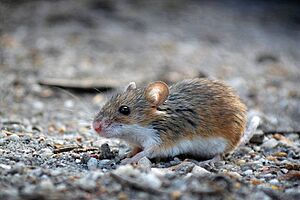African pygmy mouse facts for kids
Quick facts for kids African pygmy mouse |
|
|---|---|
 |
|
| Photographed in Western Cape | |
| Conservation status | |
| Scientific classification | |
| Genus: |
Mus
|
| Species: |
minutoides
|
| Synonyms | |
|
|
The African pygmy mouse (Mus minutoides) is one of the tiniest rodents on Earth. These small creatures live all over sub-Saharan Africa. People also keep them as pets in other parts of the world.
Like the common house mouse, the African pygmy mouse belongs to a huge group called Muroidea. This group includes more than 1,000 different species of rodents. The African pygmy mouse is very similar to another species, Mus musculoides.
Contents
What Does an African Pygmy Mouse Look Like?
African pygmy mice can be grey or a brick-red color. Their bellies are usually pale. They have small, triangle-shaped ears that stick out.
Adults are about 30 to 80 millimeters (1.2 to 3.1 inches) long. Their tails are shorter, from 15 to 40 millimeters (0.6 to 1.6 inches). These tiny mice weigh only 2 to 12 grams (0.07 to 0.42 ounces). That's less than a few paper clips!
Life Cycle and Babies
African pygmy mice are ready to have babies when they are about 6 to 8 weeks old. The mother carries her babies for about 20 days.
A mother pygmy mouse usually gives birth to about three babies at a time. The babies are born blind and without fur. Their eyes open after about two weeks. They stop drinking their mother's milk after four weeks. In the wild, these mice usually live for about two years. However, some have lived for over four years when kept as pets.
Cool Facts About Pygmy Mice
The African pygmy mouse has some very interesting habits. One unique thing they do is stack small pebbles in front of their burrows.
Overnight, these pebbles collect dew, which is tiny drops of water. In the morning, the pygmy mouse drinks the dew from the pebbles. After getting their drink, they go back into their cozy dens.
Another interesting fact is about how their sex is determined. Unlike most mammals, some African pygmy mice with XY chromosomes (which usually means male) can actually be female. This happens because of changes in their X chromosome.
These mice often live in groups or pairs. They prefer grassy areas near water. They are also excellent climbers, which helps them find food and stay safe.
Pygmy Mice as Pets
Many people enjoy keeping African pygmy mice as pets. Since they are social animals, it's important to keep them in pairs or small groups. They need friends!
These mice have simple care needs. They are active during both the day and night. However, you cannot really handle them. They are so small that you might accidentally hurt them. Also, they tend to jump when they get scared. Despite their tiny size, they can jump up to 50 centimeters (nearly 20 inches)!
When kept as pets, they are often housed in covered aquariums. This helps make sure they don't escape, as they are very good at squeezing into small spaces.


